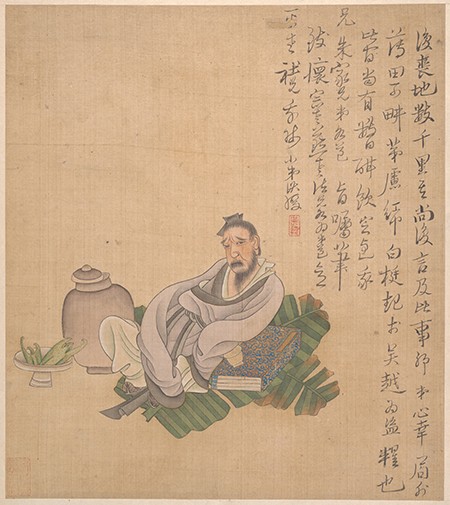The eclectic and experimental Chinese figure painter Chen Hongshou 陳洪綬 (1598/1599–1652) experienced the many political, economic, and social changes of the mid-seventeenth century. As a poet, Chen fashioned a series of discordant selves that engaged the varied, unstable circumstances of his life. In my current research on his painting, I have focused on how he responded to and shaped the media revolution of the late Ming dynasty (1522–1644). This revolution saw the final ascendancy of the woodblock-printed book over the manuscript, along with an unprecedented increase in the production of illustrated books. Illustration not only advanced visual forms of knowledge across social boundaries but also sparked artistic experiments at the intersection of print and painting. In this vibrant and competitive environment, few artists worked in these two media with as much wit as Chen. Unlike his contemporaries who exploited the duplicative capacity of printing, Chen transformed his painting through the appropriation of pictorial and bibliographic conventions ordinarily confined to woodblock-printed books.
My research suggests that Chen’s engagement with seventeenth-century print culture—and, in particular, the demand for narrative illustration—encouraged him to explore the artifice of pictorial composition. Ultimately, Chen experimented with the juxtaposition of incongruent pictorial conventions and manners of drawing, all contained within a bookmaker’s frame. His choice, for instance, to model with graduated colors a facial type taken from printed illustration challenged viewers not only to acknowledge the image as a fabrication but also to perceive it simultaneously in contradictory ways. Chen’s propensity for juxtaposition is echoed in late Ming treatises on art. The writer Li Rihua (1565–1635), for example, described landscape painting as an assembly of formal units, which secondarily assumed the shape of a mountain. Thus, the distorted shapes that distinguish Chen’s paintings do not merely show his affinity for the quirky manners of representation derived from his study of forged antiquities; rather they are embedded in a more sophisticated project to reconceive what a picture is and how it is perceived.
At CASVA, while I discovered aspects of late imperial Chinese culture that pertain to my book on Chen’s figural art, I also learned about seventeenth-century European print culture and painting. I find compelling Victor Stoichita’s analysis of how, in early modern Europe, disparate genres and styles framed within a single image created the possibility of understanding a painting as a representation. Nonetheless, after studying a number of engravings and chiaroscuro woodcuts by Hendrick Goltzius (1558–1617) in the National Gallery of Art collection, I am convinced that the preoccupations of “early modern” European artists are not directly relevant to a study of late imperial Chinese print designers. The virtuosic demonstration of skill in the work of Goltzius is astonishing, but the strangeness of Chen’s work relates neither to skill nor to the representation of musculature, which symbolized an autonomous will or agency among early modern European artists, including Goltzius. After all, the concept of “muscle” did not exist in traditional Chinese medical theory. Comparisons drawn between seventeenth-century Chinese and European writers and visual artists, which have recently proliferated, may be informative insofar as they illuminate how a similar issue was differently treated by a Chinese artist and a European artist. But I remain skeptical of finding exact correspondences.
During the past months, I have also studied rare seventeenth-century Chinese illustrated books in the Library of Congress. Most important among these for my research was a household encyclopedia that comprises a physiognomy manual. In this manual, neither illustration nor text focuses solely on how the shapes of a nose or an eyebrow embody a person’s destiny to be wealthy or poor, long-lived or short-lived. A picture labeled “lonely bitterness” is accompanied instead by a text that identifies the physical characteristics that result from this specific state of mind. I concluded from this study that the manifestation of emotion on the face acquired new value in late Ming times. This proposition contradicts the prescriptions that ordinarily governed the representation in Chinese art of the elite male subject, in particular, which was expected to be decorous and subdued.
My research resulted in a journal article entitled “Chen Hongshou’s Laments,” which will also be incorporated into a chapter of my book. Unlike many scholars who have written about Chen, I am not inclined to suggest that he was engaged with the late Ming “cult of qing (emotion).” To the contrary, my research shows that Chen embedded his most arresting images of sorrow or shame in illustrations of poems and historical events. Recollected words contained and sanctioned his strangely expressive bodies. Although the wariness that surrounded the perception of visual phenomena remains to be examined, the book I am writing will be the first to consider Chen’s work in light of his understanding of pictorial representation.
